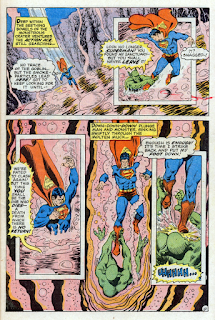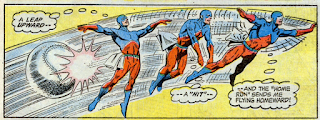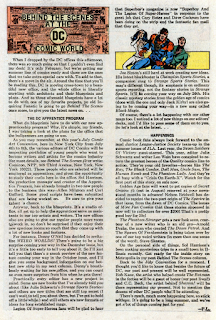A comic review of art, storytelling, and theology.
September 1973
COVER GRADE: B
Penciler: Nick Cardy
I like this cover in the sense that it grabs your attention and asks an odd question that makes you want to read the story and that's really the purpose of the comic book cover. The art is finely detailed yet smooth and bright.
My biggest complaint is that the design is 100% focused on getting you to read the story. So for me, after I've read the story, the cover loses something because it doesn't stand up on it's own.
STORYTELLER'S GRADE for "The Man Who Never Lived": B
Writer: Cary Bates
In the 21st Century, a boy is trained since birth as a telepathic weapon. He is conditioned to obey every command of his masters. When his telepathy is perfected, they send him to assassinate an ruler seeking interplanetary police, but unbeknownst to his capturers, this unwilling assassin has also developed Extra-Sensory Projection which allows him to project his consciousness back in time to 1973 to prevent his ancestors from from getting together thus ceasing his existence and preventing the possibility of assassinating the benevolent ruler. When the consciousness of the assassin arrives in 1973, takes over the mind of Wade Bartox as he is about to ask his psychiatrist Dr. Nancy Soams out on a date. Wade is transformed into a monster that Nancy recognizes from her investigations of Wade's nightmares in childhood. Superman pursues the monster all the way to the planet Mars. In the battle the monster uses mental energy to alter the physical structure of Superman's body including the part of Superman's brain that controls his powers. As the monster drags Superman to the core of Mars, he explains his troubles in the future and why Wade and Nancy must not marry. During the monologue, Superman finally figures out how to activate his heat vision and boil the core of Mars. This causes both Superman and the monster to erupt out of a volcano on Mars. As they reach the surface, the mental presence of the assassin has disappeared returning Superman and Wade back to their normal state. Superman wraps Wade in his indestructible cape for protection and heads back to earth. Meanwhile the mental energy of the unwilling assassin returns to his body in the 21st century right as his target appears. The assassin fades from existence proving his mission to split up his ancestors was successful and the peaceful ruler is saved.
I really wanted to like this story more. The writer is handed the title "The Man Who Never Lived" and comes up with a creative tale mixing future and present with a foe that can actually give Superman some real trouble. There were a lot more interesting twists and turns that I didn't mention in the synopsis even though they were interesting plot points.
The big problem for me is that although the story is incredibly creative, it feels a little disjointed. It's like enjoying a movie while you watch it but leaving the theater thinking that it didn't make much sense. I would guess that the writer came up with a few very creative ideas and then decided to shoehorn the full plot into it while making it fit the story title they gave him.
I did enjoy that they added some education bits to it.
ARTIST GRADE for Superman: A
Penciler: Curt Swan, Inker: Murphy Anderson
Let's see...
Really detailed futuristic worlds
Cool flashback paneling
Mental time travel
Monsters bursting into flames
Getting dragged into a volcano...
...only to erupt back out.
On second thought of my story review, maybe the writer put the plot together just to let the artists have some fun.
I would have given the art an A+, but it got reduced to an A because there was one drawing choice that really ruined it for me since it played a role in the plot. When the monster physically alters Superman to disrupt his control of his superpowers, the monster turns Superman into a cyclops.
But he still has shading where his eyes should be. Maybe that's an artist interpretation to emphasize the change or something, but why get stuck in a semi-realistic concept now? You're already having Superman fight a man turned into a monster by the mental powers of a futuristic assassin in a volcano on Mars! How's that for a ridiculous sentence! We passed any specs of realism long, long ago! Just go Whole hog and make Superman a legit cyclops without the normal eye shadowing. This story deserves a true cyclops Superman!
Update: I did some research and saw that many classic artists followed this artistic style of a cyclops...
...but to me that is insignificant next to the fact that in 1958 Ray Harryhausen created a ridiculously awesome cyclops for the filmThe 7th Voyage of Sinbad.
You have no excuse for a crappy cyclops!
STORYTELLER GRADE for "The Time Thief Strikes But Once": C
Writer: Elliot Maggin
Action Comics reverts to only two stories this month, back down from the three stories they told in the last two issues.
The Atom is challenged by Chronos to solve a clue to find him or an innocent man will die. The Atom solves the clue, saves the man, and defeats Chronos all while standing up his fiancé who is upset at his late arrival.
An all around average story.
The clue turns out to be a note left at the last place they fought which is at the Ivy University at second base. I considered trying to figure out which issue this occurred in but it didn't seem worth it. The note says:
It turns out the clue is the date. In 1973, 2/5 was not a Sunday. The clue points out the 25th Anniversary celebration of "Sonny" Apollo the Ivy University Athletic Director and baseball coach. 25 is ok, but Sunday to Sonny is a big stretch. It's more obvious that the note is found at the baseball field and contains a baseball reference of only needing one strike. It's more clever the pin of strike for a clock and for baseball. The author was trying to give you all the clues before giving the answer, but who really stops and does that when the answer is on the next page. The comic introduces the 25th Anniversary celebration as the date night the Atom is going to miss because of the clue, when you could have just as easily reversed the steps so that because his fiancé calls to remind him of the 25th Anniversary celebration which helps him solve the clue. It's all just a little too sloppy to me.
I almost gave this story a C- minus but I left it at C because of two interesting plot points that although I didn't like either of them, I have to give the author credit for trying something different.
The first interesting part is that the comic starts with Atom being unwilling to help and would rather the police get involved. But when Chronos threatens that a man will die if the Atom isn't the one then he gets ready for action. It's a different dynamic to showcase a reluctant hero, but I'm not sure if I like it or not.
The second is a well written interaction be the Atom and his fiancé, Jean Loring to close the story. Ray Palmer (alter ego of the Atom) basically stood up Jean because he was off fighting Chronos. As they drive home Jean passive aggressively attacks Ray for not being there. Although it is really well written, I really don't like it. It just rubs me the wrong way. Unfortunately it seems like it happens a lot in the Atom comics and perhaps is a precursor to their future divorce later. Although it may be a realistic picture of relationships and incredibly well written, I still don't like seeing it.
ARTIST GRADE for The Atom: A
Art: Dick Dillin and Dick Giordano
What comic lacks in story, it makes up for in art. The paneling is basic and straightforward, but the action is great and the pictures are fun.
The Atom rides a note...
...then a fly ball...
...then a telephone line...
...then punches Chronos in the nose.
That wasn't all in one motion mind you, but still the Atom does ride on top of a lot of stuff.
THEOLOGY GRADE: A+
The Superman story asks the age old question of what is the value of one human life compared against another. The assassin decides that his target's life is worth more than his own, but he is missing an important truth. The futuristic assassin makes the decision to travel back in time "over one hundred years" in the past and stop his ancestors from making babies. Given a generic stat of about 25 years per generation, that gives you at least 4 generations, meaning that the mental assassin stops his great-great-grandparents from getting it on. If there are two kids per person per generation calculated over 4 generations, that means that not only did the mental assassin make himself disappear, but probably 30 other people also. So is this future King of Peace worth the "death" of 30 people. You might argue that it depends on the contributions that those 30 people made. If one of those people cured cancer then maybe it's not worth it. If one of those people was a mass murder than maybe it was worth it just to get ride of that one guy.
To me it seems like there are two ways to measure the value of a single human life. A measurement of worth in this exact moment or the value of a person over a period of time. For example, let's say two construction workers apply for a job. One worker is 25 years old with 1 year of experience and one is 60 with 35 years of experience. Which one do you want to hire to oversee the building of your house? The 60 year old has more value because of his history of experience. But now which one would you hire if the job is a thirty year project to build 100 houses? Now the 25 year old has more value based on future potential value over that period of time. Another though experiment would be to look back at history and ask who were the most important people who ever lived? I quickly searched for a few separate lists and found a lot of similar names at the top of the lists: Jesus, Napoleon, Mohammed, William Shakespeare, Abraham Lincoln, Aristotle, Isaac Newton. These people are all iconic. Even my buddy Jesus made the list! So obviously each one of these men is worth at least 100 "normal" people, right? Again I think this idea is completely bound by perspective. What if we asked a predominantly Hindu country that has been entirely influenced by Eastern Culture to list their most important people in the world? Would any of these names even make the list? What about you today? What direct value did William Shakespeare add to your life today? On this train of thought, let's now stretch our time frame out to millions of years into the future. Let's say that there have been no humans left in the universe for a million years. What was the value of a individual human then? At this point I think that the value of each human life has pretty much equalized. On this super-large scale, every human is worth the same and unfortunately it's probably not very much.
Now there is one exception to this rule for me which is a little bit cheating. When you asked the question of which of these important historical figures still really impact you today, for me there is one: Jesus. It's a little bit cheating in my mind because although Jesus was human He was also God. His life's work was to sacrifice Himself so that any human for all time could be reconnected with their creator, God, for all eternity. That time scale never ends so that value ever decreases.
For this is how God loved the world: He gave his one and only Son, so that everyone who believes in him will not perish but have eternal life. God sent his Son into the world not to judge the world, but to save the world through him. John 3:16-17
So for me in an ideal philosophy I would give each person equal value, but the true focus is on God.
CLARK KENT’S MONTHLY GOOF:
All Clark did this week was hide in a van when the monster showed up so that onlookers could follow the standard procedure of making fun of him for being a coward right before Superman busts out of the van. Anybody made these connections between Clark and Superman yet?
EXCESSIVE USE OF FORCE:
Superman super-heats the core of Mars by millions of degrees to cause the volcanic eruption on Mars. That can't be good for the planet, but this is one instance where Superman was really forced to use his powers excessively. So it's still excessive but warranted. At least there should be no innocent bystanders on Mars.
DEAR EDITOR (seen in #431):
Not surprisingly the readers enjoyed the Superman story too. Although there is an interesting letter that points out that some of the best stories from Superman recently where tales where the Man of Steel was only a minor character such as this story. You could have done it all without him. An interesting development that the editor quips back with "You try to write two Superman stories a month for 35 years and see what you have to do to keep it fresh!" Good point.
The Amazing World of DC Comics
A new feature appears in this issue discussing the behind the scenes at DC Comics that discusses their Apprenticeship Program. They name drop two people that are going through it, Al Milgrom (ironically more famous for the work he did at Marvel two years later) and Carl Gafford (mostly know for his work on The Amazing World of DC Comics and The Legion of Super-Heroes).
A new feature appears in this issue discussing the behind the scenes at DC Comics that discusses their Apprenticeship Program. They name drop two people that are going through it, Al Milgrom (ironically more famous for the work he did at Marvel two years later) and Carl Gafford (mostly know for his work on The Amazing World of DC Comics and The Legion of Super-Heroes).






















